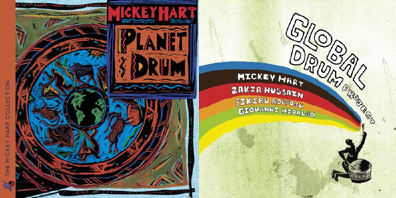Drum solos at Grateful Dead shows were anything but ordinary drum solos. The uninitiated may have thought it was the perfect time to grab a beer and take a leak, but seasoned Deadheads were only too aware that the “drumz” portion of the show was a spiritual communion in collective consciousness, a sanctified gathering with a heartbeat, the calm before the electrical storm unleashed by Jerry Garcia, Bob Weir and Phil Lesh. At the helm were the Dead’s two stickman, alternately known as the “Rhythm Devils” — Bill Kreutzmann, the band’s original drummer, and Mickey Hart, a self-styled percussionist and author with a yen for the exotic and quirky. Kreutzmann tended to keep things fairly basic and solid. Hart, on the other hand, utilized an approach that danced with color, texture and cultural bravado. That approach led to several non-Dead recordings and collaborations that comprise The Mickey Hart Collection, recently reissued by Shout! Factory.
Even before the Grateful Dead called it a day after Garcia’s passing, Hart was exploring the netherworlds of percussion. In 1972, he released Rolling Thunder, his first solo album (and not part of this set), which touched on elements of what would eventually become known as “World Music.” He also started an ongoing musical relationship with renown tabla player Zakir Hussain. Three years later, Hart and Hussain formed the Diga Rhythm Band, and the two set out to record their debut album, Diga. Here, they ventured even deeper into a drum-driven drone that included Garcia on guitar. Other collaborative, percussion-based albums would follow, but no one could have predicted the response to 1990’s At The Edge or its follow-up, the highly acclaimed, Grammy winning Planet Drum.
Planet Drum is an international summit of percussionists whose styles collide and erupt into a sound collage resonating with wonderful and woefully hypnotic grooves. For Hart, Hussain, T.H. “Vikku” Vinayakram, Sikiru Adepoju, Babatunde Olatunji, Airto Moreira, Giovanni Hidalgo and Frank Colón, Planet Drum celebrates a unique cultural meld and diversification through the process of polyrhythm. The record went onto to spend an incredible 26 weeks at the top of Billboard’s World Music chart. That was enough juice for a Grammy, the very first one in the World Music category.
Hart’s credibility grew beyond the confines of the Grateful Dead, but he didn’t make another record until a year after the group disbanded. Consequently, the intent behind 1996’s Mickey Hart’s Mystery Box is one of mixed passion, disorientation crossed with an ambitious outlook, a marriage of convenience for the sake of inconvenience. The dashes of percussive palpitations underscore the pop posturings, resulting in a satisfying and experimental ode that features Robert Hunter lyrics sung by the Mint Juleps (a four-sister singing troupe) and, for the very first time, Hart himself.
For 1998’s Supralingua, Hart picked up from where he left off with Planet Drum. Most of the same players (dubbed collectively as “Planet Drum”) appear for a few rounds of super-sized rhythms and beats. Almost 10 years later, a similar groove transcends the aura that bleeds and blossoms on 2007’s Global Drum Project. This one’s a true infusion of Indian and African pulsations that pitch and sway amongst the sitar, guitar and assortment of samples and voicings. One listen to “Kaluli Groove,” featuring the Kaluli tribespeople of Papua New Guinea’s rainforest, is enough to transport the mind and spirit to another dimension of space and time.
These days, Hart’s recording obligations alternate between commitments to the Library of Congress, writing and traveling the world in search of the next discordant thud. He’s back on the road with Steve Kimock for a series of shows this summer. And there’s talk of another Dead tour somewhere down the line. At which point, Hart and Kreutzmann will dazzle the Deadheads with an updated “drumz” section while various misdirected malefactors shuffle over to snack bar for an overpriced cocktail. Hopefully, their numbers have dwindled.
~ Shawn Perry




















